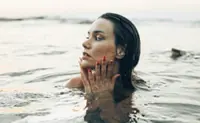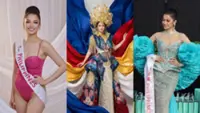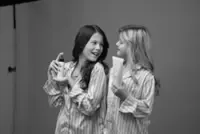A retro beauty setup in New York, July 8, 2024. Youth might be wasted on the young, but beauty trends rarely miss them. Photo: The New York Times
Youth might be wasted on the young, but beauty trends rarely miss them.
Although a spate of recent headlines has centred on the “Sephora teens” who run like wolf packs through the aisles of the personal-care retailer, snapping up rarefied lotions and lash-growth serums, the adolescent urge for transformation is hardly new.
The concept of teenagers as their own distinct marketing demographic first emerged during the postwar boom of the 1940s, though for many years, the products catering to them remained relatively modest: a pink froth of bubble bath, a smattering of Lip Smacker lip balm.
This year, the global beauty industry is projected to generate more than US$600bil (approximately RM2.8 trillion) in revenue, with an 8% rise among teen and tween consumers alone.
Below, a partial look back at the last eight-plus decades of shimmer sticks and zeitgeist shifts.
1940s
The debut of Seventeen magazine in 1944 helped to promote a fresh-faced glow via products such as Pond’s Angel Face Powder and growing brands like Tangee, whose bestselling lipstick contained a fluorescein dye that changed colour upon skin contact to uniquely suit the wearer, or so the company claimed.
Also emerging around this time: the popularity of miniature products – known as “10-cent sizes” and initially sold as samples – as a boon to girls with little experience and limited money to spend.
1950s
In 1952, a British businessperson acquired the trademark rights to "Tinkerbell" and began manufacturing toiletries and cosmetics designed specifically for young girls.
The line would go on to feature an enduringly popular line of bath products, lipsticks and “Bo-Po” peelable nail polish, though the company eschewed eye shadow or mascara.
“We don’t want to tell an eight-year-old that she should look like she’s 18,” the company’s president told The New York Times in 1989.
Alas, it was all headed for Neverland; by the turn of the millennium, an ongoing lawsuit with Disney over naming rights shuttered the brand for good.
1960s
Enter the youthquake, and with it a new era of marketable teendom – perhaps most memorably embodied by lithe early supermodel Twiggy, whose exaggerated Bambi-like underlashes, pixie haircut and pale lips made her a star at 16.
For that look, false eyelash strips were a must, as well as bright pencils and powders from Cover Girl, Max Factor or Maybelline.
Also all the rage, if considerably less low-maintenance than the pixie: beehive hairdos, initially created by a Chicago beautician named Margaret Vinci Heldt and soon adopted by rising girl groups like the Supremes and the Ronettes.
“It’s all about Aqua Net, and then teasing it, and then more Aqua Net, and then teasing it a little more,” Ronnie Spector, the Ronettes’ famously diminutive lead singer, explained in a 2010 interview.
Read more: In Malaysia and around the world, tweens are fast shaping the beauty industry
1970s
As mod gave way to the Woodstock generation and later the dawning of disco, looks both softened and expanded to convey a more carefree kind of glamour (see the fragrant rise of groovy shampoos like Clairol Herbal Essences and Gee, Your Hair Smells Terrific).
Bonne Bell Lip Smacker, introduced in 1973, let teens eschew the waxen, heavily pigmented lipsticks of their mothers’ era in favour of sheer balms in collectible flavours like strawberry, green apple and Dr Pepper.
For the girl perhaps a little more versed in the ways of romance, there was Maybelline Kissing Potion, a roll-on lip gloss available in cheeky formulations like “Provocative Pineapple”, “Wild Watermelon” and “Devil Mint”.
Also new in 1973: Fashion Fair Cosmetics, which was among the first mass brands to cater to Black beauty needs.
At the same time, the unfettered hair of counterculture icons such as political activist Angela Davis signaled a shift away from damaging straighteners toward products like Afro Sheen that celebrated natural textures.
1980s
A booming economy and the big hair to match: The Greed Decade welcomed the rise of crimping tools, Ogilvie home perms and other products designed to pump up the volume.
Many teens chose to boost their spiral perms with Sun In, a heat-activated spray that promised natural highlights, though it more often delivered unseemly streaks of metallic orange.
And to sweep those curls up, preferably to one puffy side? Enter the scrunchie, that wrist-ready twist of fabric and elastic first patented by a former nightclub singer named Rommy Hunt Revson. Or, in a literal pinch, there were always banana clips.
Makeup of the 80s, too, had little use for subtlety – whether in bright neons, frosted pastels or the saturated shades (teal, orchid, cobalt) produced in teen-friendly price ranges by Wet N Wild.
Later, it could all be wiped off with a bracing swipe of Sea Breeze astringent, and the afterburn covered with a crop-dusting spritz of Electric Youth, Love’s Baby Soft or Malibu Musk.
The bulky, ubiquitous vessel in which to stash all this bounty: the Caboodle, a brightly colored, multilevel case inspired, legend has it, by a fishing tackle box that Vanna White used to organise her cosmetics on the set of Wheel Of Fortune.
1990s
While corporations targeted the emerging “alternative” sensibilities of a young and jaded Generation X, beauty also turned away from 80s glam and excess.
MAC Cosmetics, a Canadian brand, offered matte, densely pigmented products in browns, burgundies and taupes, and subtler shimmers replaced frost.
The irreverent print magazine Sassy reflected the shift, crystallising trends that ranged from Bantu knots and baby barrettes to belly button rings. Piercings emerged in other spots too: eyebrows, noses, nipples.
The decade was not all earth tones and overtweezed eyebrows, though.
Manic Panic hair dye, vegan and cruelty-free, came in a spectrum of screaming colours available to any rebellious kid with a sink and a comb, and brash new groups like the Spice Girls and Destiny’s Child embodied the panoply of looks (cyberpunk, sporty, babydoll) that filtered down from the pop charts to the local mall.
2000s
As grunge receded and MTV’s Total Request Live era entered the chat, things got a little shinier and more girlish again: butterfly hair clips, eye shadows in Easter-basket hues, lip products so high-gloss that they looked like car paint.
The rise of emo and pop punk also brought a new coed twist to grooming: the boom in “guyliner” for boys, along with assiduously flat-ironed hair for all.
The upstart makeup line Urban Decay offered more genderless options in provocatively named shades (Absinthe, Gangrene, Asphyxia) that deliberately eschewed “pretty”.
Fragrances could be unisex, too – see the enduring appeal of CK One, introduced in 1994 – but mass-market offerings like Axe body spray, introduced by Unilever in 2002, helped to democratise scent, steeping a generation of teenage boys in an ambient, often eye-watering cloud of musk and metrosexuality.
Was it deodorant, cologne or chemical warfare?
Ask the girls who drenched themselves in analogous potions from Bath & Body Works and Victoria’s Secret Pink, their candy-coloured mists aggressively evoking melons, berries or warm cookies.
Read more: Skin doctors caution against kids using beauty products meant for adults
2010s
The continued rise of social media and YouTube helped to spread the gospel of previously niche items like nail art, Korean skin care and ombre hair via self-styled influencers and “get ready with me” videos.
Increasingly, too, the messenger was as notable as the medium, thanks to product lines from celebrities including Lady Gaga (Haus Labs) and Kylie Jenner (Kylie Cosmetics), who cannily extended (and monetised) their brands.
2020s
Glazed Donut, Strawberry Girl, Coquette, Cottagecore: The ascendancy of TikTok-driven microtrends has often made beauty feel like a game of free association or a chaotic grocery list.
Even faux freckles became a viral hit when applied with a broccoli floret (no, really).
And broccoli is also for boys, as evidenced by the highly meme-able haircut of the same name (long on top, cropped or faded on the sides).
All genders took cues from Euphoria, the boundary-pushing HBO show whose high school hallways spilled over with eye gems, bright iridescents and other outre looks. – The New York Times





